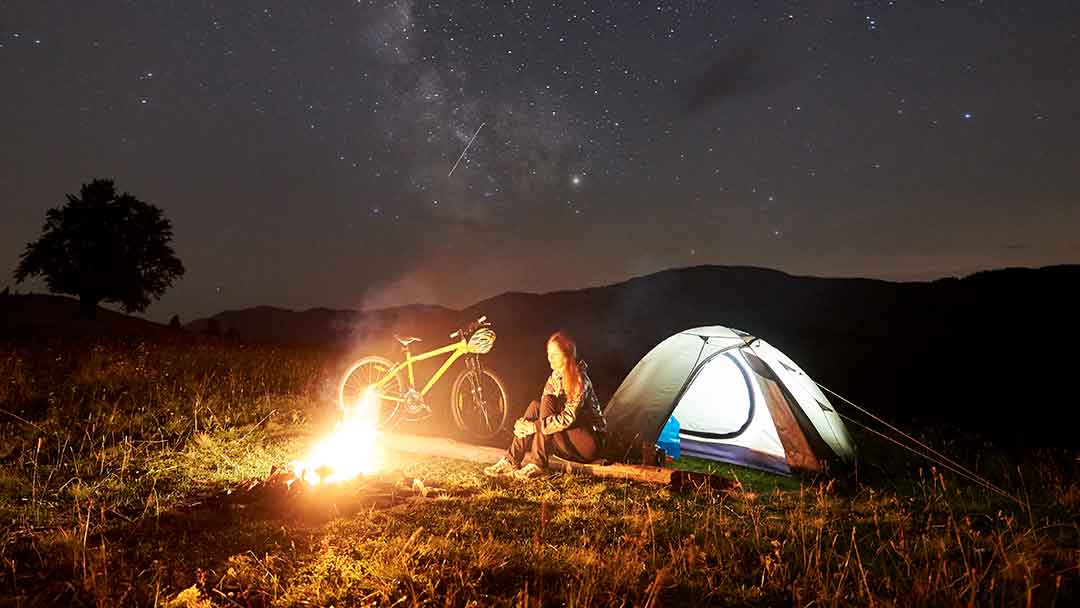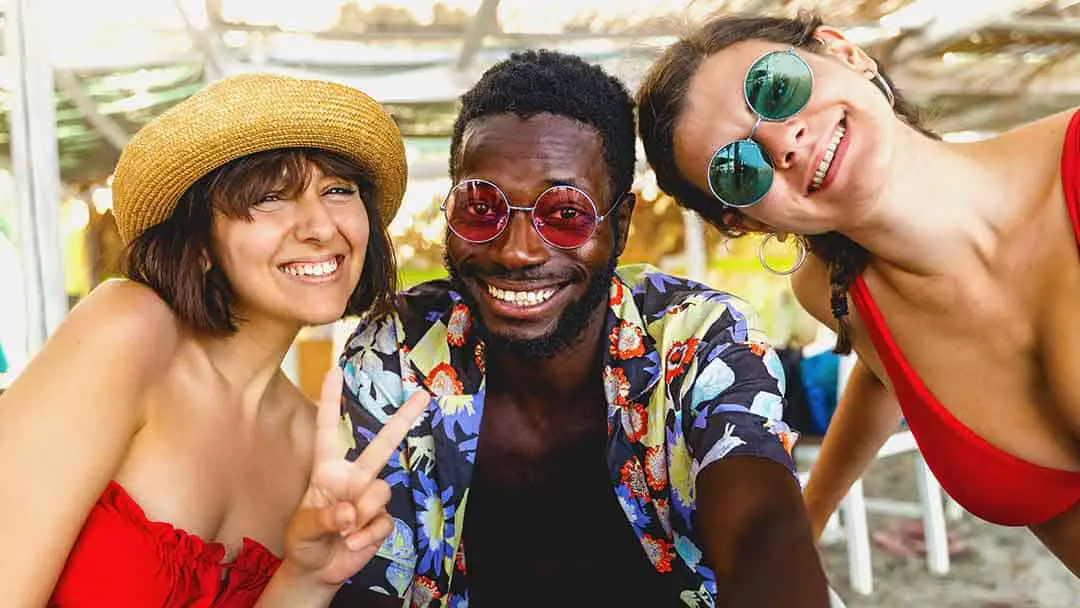Where to Camp When Bikepacking?

As an Amazon Associate we earn from qualifying purchases made on our website. If you make a purchase through links from this website, we may get a small share of the sale from Amazon and other similar affiliate programs. You can read our complete legal information for more details. By using this site, you agree the information contained here is for informational purposes only. For specific medical questions, consult your doctor. NO information on this site should be used to diagnose, treat, prevent or cure any disease or condition.
A few years ago, I traveled to Peru with a school group where we hiked up to the top of Machu Picchu. As enjoyable as this was, to this day, I wish I had my mountain bike to ride it up this pathway!
Camping is an important aspect of bikepacking and, for many adventurers, an essential aspect. You should camp in a safe, quiet space where you can indulge in nature away from cities. Public parks and private campgrounds are the best options but not the only available.
Camping spaces will differ depending on the country or countries you’re planning to travel through. To learn all about where to stay no matter where you go, you’re in the right place!
What Are the Best Places to Camp When Bikepacking?
Where you choose to camp during your bikepacking trip depends upon location and needs. Generally, public parks, lands, and other government-owned property are the best choices. However, you can also find great private campgrounds or parks to stay the night or a few days.
Bikepacking is a safe outdoor experience if you know what you’re doing before you get out. You should never leave without proper supplies and adequate conditioning. Three things you should always consider before planning your trip are:
- What do I need?
- Where am I going?
- What’s my goal?
Is your goal to experience peace in nature, but you aren’t worried about the costs? Do you want to feel like you’re a part of nature but don’t want to be too far from civilization?
Do you want to see the world? Do you want to visit various countries or states?
Consider these questions when choosing your camping destinations. The best overall choices should be safe. Safety is one of the most critical aspects when choosing your path.
Know your surroundings and try always to be as close as possible to essential places. Sometimes you might be miles away from the nearest grocery store or hospital. If you’re in a foreign country, you might be hundreds of miles away from the American consulate.
Below we’ll dive into the best advice for camping in different regions of the world. But before we do, are you familiar with the difference between Bikepacking and Bike Touring? If not, this article will help explain the crucial difference.

North America
Biking in North America, which includes the USA and Canada, is relatively safe and somewhat predictable. Thanks to the sheer vastness of these two countries, you will be able to indulge yourself in almost any length of travel.
The U.S. and Canada have a lot of public parks, campgrounds, and other public spaces for travelers to camp. Ideally, you should look for a public park or campground to immerse yourself in nature under the stars.
For those looking to plan a trip across the U.S., familiarize yourself with these sites:
- Bureau of Land Management
- The Fish and Wildlife Services
- Forest Service U.S. DEPARTMENT OF AGRICULTURE
- National Park Services
- Map of the US Geological Survey (USGS)
These sites offer interactive tools and useful links for traveling across the continental U.S. Although not specifically designed for bikers and campers, these websites will help you locate public grounds.
For those looking to plan a trip across Canada, familiarize yourself with these sites:
- Canadian Wildlife Conservation
- Parks Canada
- Ministry of Nature and Forestry
- Ministry of Minerals and Mining
The Ministry of Minerals and Mining doesn’t list areas where you should go camping. However, it’s essential to understand where mines and mineral deposits are available to avoid them.
Mining can be dangerous. The ground may not be sturdy or settled enough for biking due to regular mining and digging.
Park Canada is an excellent resource. This is very similar to the Parks Department in the U.S. This website will help you avoid private lands owned by farmers or native people.
These spaces are fairly safe and regulated by the Federal governments of their respective nations. Although, due to the length of Canada and the U.S., you must be prepared for different weather and animals.
The weather varies vastly between the east and west, and you’ll have to contend with large mountain ranges. Plan your trip accordingly and avoid taking this journey during the winter.
Biking in South America
South America is a little more tricky for bikepacking. First, this phrase could refer to Mexico or down south by Chile.
The cultures, traditions, governments, economies, and terrain of these various nations differ significantly. Mexico has a warm, hot, and wet climate. Chile is close to Antarctica and has a cool, dryer climate.
The Andes Mountains cascade through most of western South America. These mountains are a thrilling set of mountains for the adventure seeker, but they can be dangerous. However, if you feel prepared for a rough trip, these mountains hold amazing views and historical significance.
Additionally, it’s vital to understand the various political climates of the areas. While nations such as Colombia and Peru have a firmer grip on Narcos, others are more volatile.
The U.S. State Department offers helpful advisories and travel warnings for those looking to take a trip overseas. For example, the U.S. State Department advises against traveling to Venezuela due to excessive crime and the detention of U.S. citizens.
There are travel advisories for Colombia and Peru due to the presence of Narcos and FARC. However, the presence of these drug traffickers is mostly restricted to certain areas. This is not the case for nations such as Venezuela.
South America has some of the best natural scenery and warm and welcoming people. As long as you know where you’re planning to travel and avoid certain areas, it is safe to bikepack through.
National parks and public lands are available in Colombia, Bolivia, and Peru. These spaces are the best options for those wishing to camp while bikepacking. Although, avoid traveling through the equator region between April-June.
This time frame experiences heavy torrential downpours. Not only can this rain be dangerous due to the presence of foreign bacteria, but it causes extreme and sudden flooding.
These floods are made worse due to mining operations in the mountains, which can cause sudden mud and landslides.

Bikepacking Through Europe and Beyond!
Bikepacking through Europe is relatively safe and an experience many young people have on their bucket lists! However, there are several restrictions in place you should familiarize yourself with before planning your journey.
Remember that each European nation is different and has a sovereign government. This sovereignty means they regulate and restrict who comes and goes through their nation. They also have different Visa and Passport requirements, so do your homework before visiting.
Bikepacking through the Holy Land and historic sites of the Middle East are popular. However, you must know where you are and your travel companions.
Portions of this trail will require you to hike and carry your bike with you. However, this trip’s historical and cultural contexts will be worth the effort.
Check with the State Department before planning your trip through the Holy Land and the Middle East. While these areas are beautiful and full of history, they can be dangerous for Americans and Europeans.
What Factors Should You Consider When Choosing a Place to Camp?
When choosing a place to camp when bikepacking, you should consider the surrounding regions. The presence and availability of water, fuel, and the area’s safety are paramount. Once the essentials of safety and water are met, you should find a place that satisfies and pleases you.
We’ve already explored some more obvious considerations when selecting our bikepacking camp. However, below you’ll find advice for other lesser-known precautions to take when adventuring out.
Terrain
The terrain of the region should be relatively flat and hospitable. It’s fine to rough it for a few days, but be cautious when planning a trip that exclusively puts you on rough terrain.
You must sleep adequately on your bikepacking trip. Additionally, avoid camping on the slope of a mountain, especially during the rainy season. This could cause a landslide which can prove disastrous if you’re camping at the mountain’s base.
Last, if you’re bikepacking through South America or the Midwest of the U.S., keep an eye on seismic activity. You can track earthquakes and volcanic activity on the Earthquake tracker.
Who is With You
Family bikepacking trips are exciting and a wonderful bonding experience. However, not every place is the best for your children or elderly family members.
Avoid these areas when traveling with children or elderly family members:
- Politically volatile regions
- Violent or extreme weather
- Impassable terrain
- Spaces requiring mountain climbing
- Avoid dangerous animals
Although you might want to give your children or grandparents an exciting trip, don’t put them at risk. Few are available to help or rescue you in an emergency when you’re out in the wild.
Therefore, plan accordingly and avoid unnecessary risks when traveling with vulnerable populations.
Health Conditions
Since you will often be far from hospitals or other healthcare facilities, bring more than enough medical supplies. If you have a pre-existing condition, plot your route so you’ll come across a medical center every few days.
One of the best ways to plot your route with a medical condition is to start by checking the estimated time of the trail. Google maps can also provide an estimated hourly time frame for biking and hiking.
Before you leave on your trip, find the hospitals and medical centers along your route using Google maps. Call these centers to ensure they’re still open and available to you (sometimes Google maps isn’t up-to-date).
Alternatively, you can use the Hospital Finder App. This app is designed for people unfamiliar with an area and helps you find help based on your personal needs or emergencies.
Bookmark these medical facilities along the path just in case you lose wifi access. You should be able to estimate your direction and distance using navigation gear and your phone’s map.

What Type of Tent and Supplies Should You Bring?
You should bring a waterproof tent that is also lightweight and small enough to carry on your bike. Bring a sleeping mat and a suitable sleeping bag for the weather conditions. Last, avoid bright-colored tents and sleeping gear, so you don’t draw animals’ attention.
Efficiency and sufficiency are the two primary needs to consider for bikepacking. You must be as minimalistic as possible when choosing the gear you take with you.
If you’re traveling with your family, this might be more difficult. If you have four family members (two kids and two adults), you should be 240cmx220cm. This translates to approximately 7ftx7ft.
Alternatively, you can each carry your tent. This is especially good if you have teenagers or older children you believe will be safe on their own.
Final Thoughts
Knowing where you’re heading before you leave for your bikepacking journey is important. Although more seasoned bikepackers sometimes wing it, we don’t recommend that until you feel fully confident.
We hope this article helped you plan your next trip, no matter where you plan on visiting! Even though some areas of the world are a little riskier, it doesn’t mean you can’t go!
Plan accordingly and track your path before leaving on your trip. Avoid dangerous places where landslides or animal attacks could occur, but ensure you find a place you enjoy!
Sources:
Travel Channel: 10 Great Bikepacking Routes in the U.S.
Ministry of Natural Resources and Forestry
Encyclopedia Britannica: Andes Mountains
U.S. State Department Advisories
Wikipedia: FARC (Colombian Revolutionary Armed Forces)
Forbes: Here Are The Current Travel Restrictions For Americans Traveling To Europe



